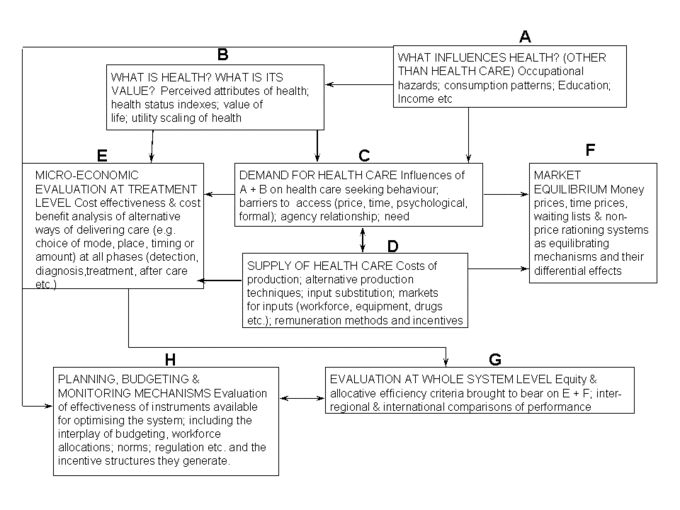Health care economics is a segment of economic study pertaining to the value, effectiveness, and efficiency in medical care and health care services and issues. The study of health care, from an economic perspective, requires taking a broad lens on a complex system with a wide variety of stakeholders. In 1963, Kenneth Arrow differentiated health care economics from other economics due to the wide range of unique considerations involved. Health care, due to the severity of the need/demand, wide variety of externalities, government intervention, and role of doctors as third-parties (making critical purchasing decisions for other people), cannot be considered from the same perspective as other industries.
Defining Health Care
Health care is a significant concern for patients, insurance companies, governments, businesses, health care providers, researchers, and non-profits. It is a vast economic system with many internal players and externalities. Understanding the basic factors involved, both logistically and economically, will provide useful context in defining health care and the medical care services.
outlines who is involved, and in what fashion.

Health Care System Flow Chart
This flow chart does an excellent job of outlining the various stakeholders and influences in the broader health care system context.
- Health (Box B): Health metrics for health attributes from a value of life and overall utility-based perspective.
- Demand for Health Care (Box C): The overall health care demand, which is a complex array of inputs that can be summarized as health care seeking behaviors, and what factors influence them (i.e. externalities, price, time, perspectives, etc.).
- Supply of Health Care Costs (Box D):The supply of health care in most systems is quite complex, inclusive of direct inputs such as drugs, medical suppliers, and diagnostics to insurance companies (third parties) to health care professionals (doctors, nurses, etc.) to research.
- Evaluation of the Whole System (Box F): This is where the government factors in, particularly in countries with a more socialized system for health care, alongside the comparisons both internally and externally.
This process flow is what defines health care and the medical industry from an economic standpoint, and the relative influence of each of these components, and the interdependence between them, is worth studying to determine where higher degrees of efficiency and efficacy can be found.
Health Care System in the U.S.
With this in mind, it is useful to also outline the inputs and outputs of the U.S. health care system, particularly during this transitional time. At the time of this writing (2013), the Affordable Care Act (often referred to as 'Obamacare') will be coming into play shortly. While the details and implications of this are beyond the scope of this discussion, it is useful to understand what the basic construct that exists in the United States currently.
At the moment, health care is largely privatized with the exception of medicaid and medicare, the former being for low income groups and the latter for retirees. For most of us, health care insurance is generally purchased on a capital market by a policy-holder (who may be a company the beneficiary works for or the beneficiary themselves, depending upon the profession and contractual obligations of an employer). This health insurance plan offers a construct for what will be covered under an umbrella of monthly health care payments, and what is considered outside of the plan. There are many large health care insurance providers out there, offering this service to prospective beneficiaries.
Now, either the insurance company, the government (medicaid and medicare), or the individual (if they are not covered or if their particular procedure is not covered) is the direct client of the hospitals, pharmacies, and doctor's offices. These institutions are also quite complicated, and require their own insurances against liability due to the high consequences in the field. Doctors and nurses provide a service, either actively performing a recommended approach (e.g. surgery) or recommending a treatment (e.g drugs). These medical professionals are largely overseen by the government from a quality control perspective (various standardized test and degree requirements), adding an additional line of complexity to the operation.
Overall, this system of healthcare in the U.S. is quite convoluted. There are many players involved and the stakes are extremely high. Picture a demand curve for a treatment for a deadly disease, what would the price point be? Considering the consequences, healthcare services often fall outside of standard macroeconomic concepts, defying supply and demand frameworks due to the nature of the business (i.e. life and death, the well-being of people). This underlines a social issue: how can we improve healthcare economics to maximize value and minimize costs?